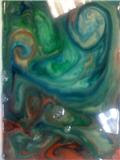Here are just a few wonderful examples!
Learn how we did it!
Introduction
Liquids like water and milk have a property known as surface tension, due to the cohesive forces of the liquid's molecules. Look closely (you can use a magnifying glass) at the edge of the surface of water in a clear glass. Do you notice how the very edge of the water appears to rise up the side of the glass? That's because the surface tension of the water is actually pulling the water away from the glass inward toward the center of the surface.
Soap will reduce this surface tension. Let's see what happens!
Safety
- Make sure you have an adult helping you.
- Do not drink the milk after you have put the food coloring and soap in it!
- Do this experiment near the sink so that when you're done you don't spill milk and food coloring all over the floor.
Supplies
- A shallow dish - One that is clear is best, to see what's happening under the surface of the liquid, but a shallow bowl, aluminum pie tin, or plastic or paper bowl will work just fine.
- Milk - The higher the fat content the better. Buttermilk, half-and-half, or whole milk works best.
- Food coloring - Four different colors will be more colorful.
- Liquid dish soap.
- A toothpick or small straw might be helpful, too.
Directions
- Pour a layer of milk in the dish about 1/2" (1 cm) deep. Room temperature milk works better than cold milk, if you have the patience to let it sit for a while.
- Carefully put one drop of each of the four food colors onto the surface of the milk, widely separated, and not in the center of the dish. Something like this:
- Get ready to watch what happens! Very carefully drop one drop of dish soap onto the surface of the milk in the center of the dish. (Be careful not to add the soap directly on top of the food coloring. You may want to dip a toothpick in the dish soap so that a small drop of soap remains on the end of the toothpick, then touch the drop to the surface of the milk.)
Observations
- What happens to the food coloring when you first put it on the milk? Why do you think that is?
- What happens when you add the drop of soap?
- What direction does the food color move when you first add the drop of soap?
- What direction does the food color move after the experiment has been running for a while?
- Does the movement go on forever? What happens?
- What happens if you add another drop of soap after the colors have stopped moving?
What's Happening?!?
You probably first noticed that the drops of food coloring just sat on the surface where you placed them. That's because food coloring is less dense than milk, so it floats on the surface, and the colors do not mix because you didn't stir the milk.
Then the action began with a drop of soap! The soap reduces the surface tension of the milk by dissolving the fat molecules, which is why fattier milk works better. The surface of the milk outside the soap drop has a higher surface tension, so it pulls the surface away from that spot. The food coloring moves with the surface, streaming away from the soap drop. Due to the convection that results from the moving surface, the food coloring may be drawn down into the liquid, only to appear rising again somewhere else. That's why it's best to use a clear bowl so you can see what's happening.
As the soap becomes evenly mixed with the milk, the action slows down and eventually stops. Addition of another drop of soap will start the process again.





No comments:
Post a Comment